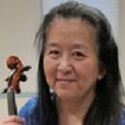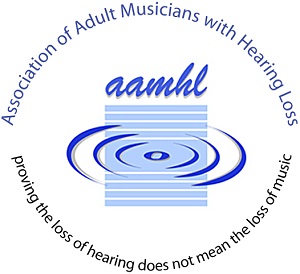The Association of Adult Musicians with Hearing Loss
Carolyn Smaka: Welcome, Wendy. Before we get in to the Association of Adult Musicians with Hearing Loss (AAMHL), tell me about your background and some of the experiences that led you to start this organization.

Wendy Cheng: I’m an adult music student, and I use bilateral cochlear implants. I’ve studied piano, violin and viola, and currently the viola is my primary instrument. I try to put an hour of practice on my viola each day and I have lesson every other week. I doubt I’ll ever becoming a professional on the viola due to the high intonation requirements needed to get to that level, but I dearly love playing the viola. I’m currently preparing for the level 5 exam given by the American String Teachers Association (ASTA) in early June.
Depending on how successful I am in completing the required aural ear training sequence requires of music majors at the undergraduate level, I may pursue a music degree one day. Cochlear implant companies do not promote systematic ear training for musical pitch perception so this could get interesting.
Carolyn: At what age were you diagnosed with hearing loss and how did it impact your music?
Wendy: My mother started me on piano lessons at the age of seven. Two years later, my hearing loss (profound on the right ear, mild on the left ear) was discovered during a routine hearing screening in the local neighborhood school. I was fitted with a behind the ear hearing aid in the left ear throughout grade school.
No one around me had much experience working with a hearing impaired music student when I was growing up. I grew up not receiving a lot of encouragement to pursue music outside of piano lessons (a solitary activity). In hindsight, this was unfortunate because I gravitated more toward aural music than any other activity in my adolescent years.
Because my parents were not aware of assistive listening devices until my senior year of high school, I did not participate in musical ensembles. I did participate in chorus for a little while in high school but was asked to leave because the choral teacher couldn't figure out how to assist someone who needed extra help to sing in tune with everyone else.
I fell in love with the sound of the violin at age 16, but I was not encouraged to take lessons since everyone thought the intonation requirements for fretless string instruments was just too high for the hearing loss in my left ear. I started violin as a college sophomore and finished Suzuki book 1 in one semester. The trick is not to depend solely on the hearing sense, but also on developing kinesthetic awareness, listening/feeling for resonant notes on the fingerboard of your bowed string instrument, and developing a feel for how much weight you need on the bow arm to create a beautiful sound.
The last 25 years of learning to play bowed strings (with hearing aids, and now with bilateral cochlear implants) have been quite a journey. I’ve learned to play in large and small ensembles (finally!) and to pass on my love of string instruments to my two daughters. I received my first implant in 1997 after losing the remainder of my hearing from a viral infection and my second implant in 2010.
I’m also venturing into playing handbells and handchimes now.
Carolyn: Tell me about your experiences - good and bad - with amplification and music.
Wendy: I consider myself lucky for the fact that throughout my hearing aid years and even after acquiring cochlear implants, I have a flat hearing loss. This is probably the "best" kind of hearing loss to have if you are a serious music student. I have been fortunate that the sound quality of my hearing aid and implant(s) have improved as I moved from piano, to violin and to viola. However, as a musician, I'm still limited by the fact that hearing devices don't do a great job of differentiating between notes which are above 1000 hertz and notes below 250 hertz. This limitation of my cochlear implant was what drove me to switch from violin to viola. And even then, I’m not 100% satisfied with how the C string on my viola sounds.
I realize that many musicians do not have a flat hearing loss like I did. Some have high frequency hearing loss. Some musicians are told “hearing aids function primarily to optimize speech, not music.” Many have reported that analog hearing aids were better for amplification of musical input than digital ones. Adults with hearing loss who are picking up musical instruments for the first time in their lives might discover their hearing aids are not doing a good job of transmitting dynamic shading (e. g., mezzo-piano and piano might sound identical in a poorly fitting aid). These are just a few of the challenges of using amplification and listening to music.
I do wish that more consumers of hearing devices and hearing healthcare providers would focus on the benefits of assistive listening devices for applied music study. They let students focus on what the teacher is saying during private lessons, and enable students to follow the teacher as he/she demonstrates a technique without having to lipread (you’re supposed to look at the instrument in many cases when they are demonstrating something). ALDs also allow a musician with hearing loss to hear the conductor even when sitting in the back section of an ensemble.
Carolyn: What are some of the challenges for audiologists who recommend and fit amplification to musicians?
Wendy: That is a great question, and I directed it to Dr. Marshall Chasin. Here's what Marshall had to say:
"I think that the challenges that audiologists face with hard of hearing musicians are similar to those that they face when working with hard of hearing non-musicians. There are a few minor differences however. Musicians are not a homogeneous group. Some musicians have super human auditory abilities, and others tend to be more like mere mortals. Some musicians perform and listen to music as an avocation, while for others, it's their day job. Also, different genres of music may require slightly different electro-acoustic parameters in the amplification. In short, a musician is really not that different than fitting a non-musician - variability seems to be the hallmark of both the hard of hearing musician and the hard of hearing non-musician. The challenges are to understand which problems and issues are software-related, which are hardware-related, and which are person-related."
 Carolyn: That's great advice. Why was AAMHL started?
Carolyn: That's great advice. Why was AAMHL started?
Wendy: AAMHL was incorporated in 2001 and received tax-exempt status in the United States in 2004. While attending a 2001 HLAA convention workshop on how music therapists teach deaf children, I realized that there were no resources to support adult musicians who wanted to keep playing music in spite of hearing loss. My resolve grew stronger when I realized that the main focus in the development of hearing devices has been increasing speech intelligibility because “speech is more important than music.” But people who choose to live vibrant musical lives through the pursuit of learning to appreciate or play music feel music and speech are both equally important.
Carolyn: What are the benefits of membership in AAMHL for musicians? For hearing healthcare professionals?
Wendy: The benefits of AAMHL for musicians with hearing loss is that we have a network of people to discuss topics of interest to us. For example, one long recent discussion thread we had was on a theoretical hearing aid that would meet the needs of performing musicians - it generated 54 responses. Another benefit is the sharing of information. For example, we may learn about apps on mobile devices that would help musicians who have hearing loss and need some extra help with intonation or dynamics.
For hearing healthcare professionals, being a part of our community gives them the opportunity to become educated on the needs of musicians and music students who want a way to keep making music even after acquiring hearing loss. Over the last two years, we’ve started holding educational events featuring audiologists and hearing researchers to discuss the research they do about music perception for cochlear implant or hearing aid users. Currently there is no membership fee to join our organization.
Our AudiologyOnline webinar series is one example of such an event. This series, as you know, featured Marhsall Chasin, AuD, who is considered one of the leading experts on music and hearing loss. Dr. Chasin presented two webinars in the series - an overview of musical acoustics for audiologists, and a course on considerations for fitting hearing aids to musicians and music enthusiasts. Dr. Brad Ingrao prensented a webinar on programming cochlear implants for music listening. We hope that these types of activities can help educate professionals as to some of the issues, and inspire further collaboration between musicians and professionals to find solutions for the unique challenges of listening to music via amplification devices.
Carolyn: Where can people go for more information or to become a member?
Wendy: Interested individuals can go to https://www.aamhl.org for more information. There are links on our website to join our groups on Facebook and BigTent. They can also send me an email at info@aamhl.org.
Carolyn: Great info, thanks so much, Wendy.


